Raphael Kirchner's influence on contemporary illustrators:
Josef Gaber
(L'influenza di Raphael Kirchner sugli illustratori suoi contemporanei: Josef
Gaber)
Born in Stuttgart in 1866, he was the author of a series of Art Nouveau postcards on the
five senses published around 1900. from ASW (A. Sockl, Wien) with individual title in German or French.
Gaber
also signed some cartoons for the Grimm brothers' fairytale book “Märchen von Jakob und Wilhelm Grimm”
published by Richard Gahl Verlag. Later Jos Gaber made advertising drawings in magazines.
Notoriety came to him in the early decades of the 1900s for the accurate engravings of him, published by Wohlgemuth & Lissner of Berlin, depicting above all dogs and horses which he defined as his closest friends. He taught at the Stuttgart Kunstakademie [Stuttgart Art Academy]. He was called to arms in the First World War and inserted as a draftsman in the propaganda section. During this period, he produced illustrations on the progress of the war for magazines of various kinds. He also signed a series of postcards dedicated to soldiers and published by Karl Voegels, Berlin.
But rather than exalting the fighters' exploits to invite greater participation in the war, Josef Gaber highlighted the implications, the most nefarious results: death, wounds, destruction and desolation. It seems to us that the author's implicit intent is to send pacifist messages through his postcards.
Nato a Stuttgart nel 1866, fu autore di una serie di cartoline Art Nouveau sui cinque sensi
pubblicata nel 1900 ca. da ASW (A. Sockl, Wien) con titolo individuale in tedesco o in francese.
Firmate
Gaber
sono anche alcune vignette per il libro di favole dei fratelli Grimm “Märchen von Jakob und Wilhelm Grimm”
edito da Richard Gahl Verlag. In seguito Jos Gaber eseguì disegni pubblicitari su riviste.
La notorietà gli arrivò nei primi decenni del 1900 per le sue accurate incisioni, pubblicate da Wohlgemuth & Lissner di Berlino, raffiguranti soprattutto cani e cavalli da lui definiti i suoi amici più cari. Insegnò alla Stuttgart Kunstakademie [Accademia Artistica di Stoccarda]. Fu chiamato alle armi nella prima guerra mondiale ed inserito come disegnatore nella sezione di propaganda. In questo periodo produsse illustrazioni sull’andamento bellico per riviste di vario genere. Firmò anche una serie di cartoline dedicata ai soldati e pubblicata da Karl Voegels, Berlin.
Ma più che esaltare le imprese dei combattenti per invitare ad una maggiore partecipazione alla guerra, Josef Gaber ne evidenziava i risvolti, i risultati più nefasti: morte, ferimenti, distruzione e desolazione. Ci sembra che l’intento implicito dell’autore sia quello di inviare messaggi pacifisti mediante le sue cartoline.
But a surprise comes to us from two postcards from the LB 16557 series signed Jos Gaber where - inserted among his faithful friends, horses and dogs - the Kirchner 's girl stands out.
Kirchner's “Lizzie” (Q.1-08), in Gaber's postcard, is surmounted by two horse heads; she always dressed as a sailor, she does not drag the boat and she is not barefoot, but, to walk the dog, she wears shoes and long pants more suitable for a walk.
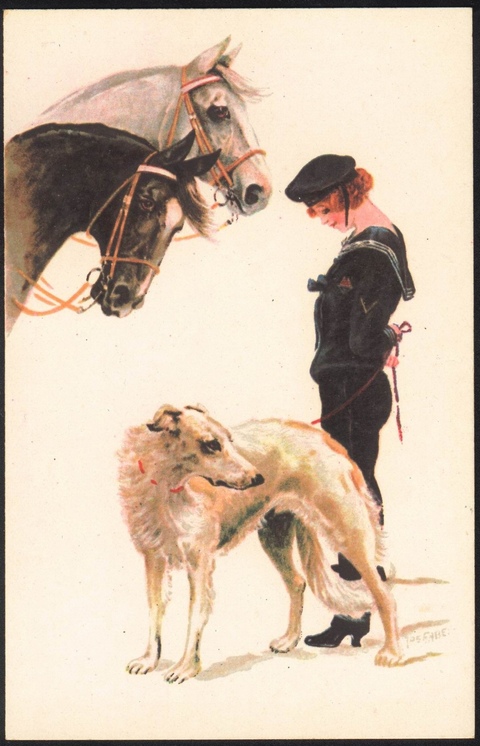
Gaber - LB-series 16557
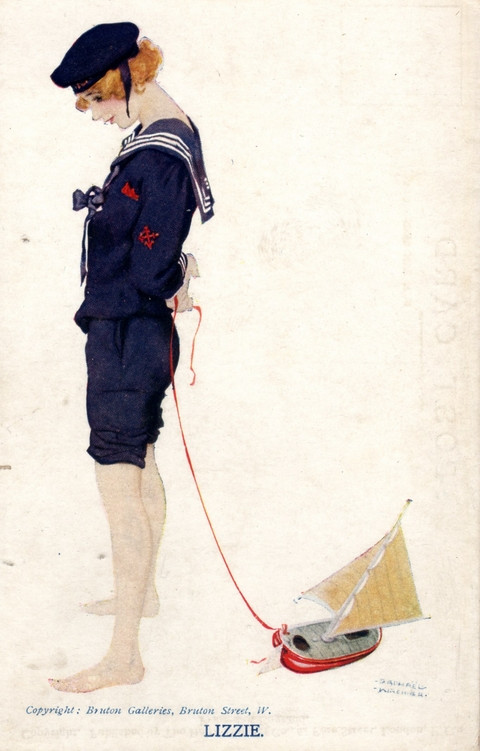
Kirchner - Q.1-08
Ma una sorpresa ci arriva da due cartoline della serie LB 16557 firmata Jos Gaber dove - inserita fra i suoi amici fedeli, cavalli e cani - risalta la "Kirchner’s girl".
La “Lizzie” di Kirchner (Q.1-08), nella cartolina di Gaber, è sovrastata da due teste di cavallo; sempre vestita da marinaretta, non trascina la barchetta e non è a piedi nudi, ma, per portare a spasso il cane, indossa scarpe e pantaloni lunghi più idonei ad una passeggiata.
In this other postcard, which takes up Kirchner's "The Scout" (Q.1-21), the water bottle is missing and the dog and horse heads appear.
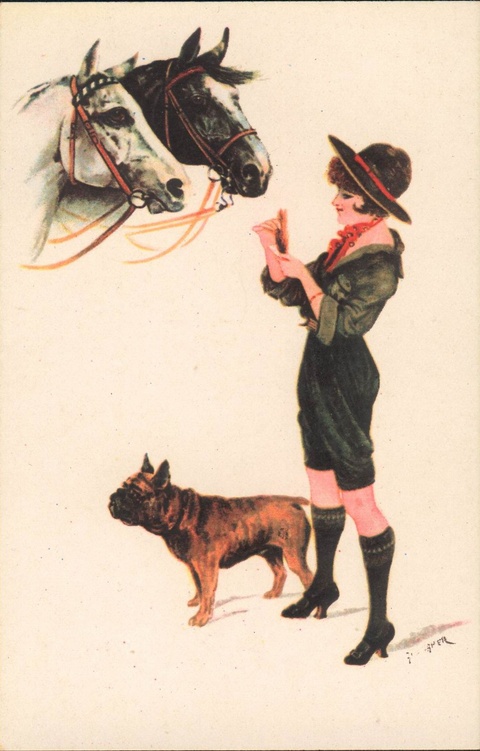
Gaber - LB-series 16557
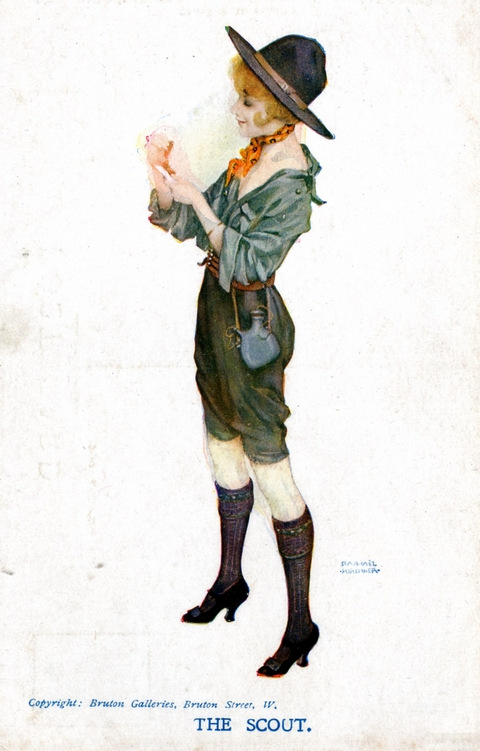
Kirchner - Q.1-21
In quest’altra cartolina che riprende “The Scout” di Kirchner (Q.1-21) manca la borraccia e compaiono il cane e le teste di cavallo.
Our astonishment increases even more when we look at another postcard by Gaber with the German title "Ins Herz getroffen" or with the French and German double title "Touchè au coeur" "Ins Herz getroffen" published by GKVB-451 (Graphische Kunst und Verlagsanstalt Berlin -Schöneberg).
It is the same image from Kirchner's postcard (N.2-7) which was very popular and widespread. Kirchner's drawing, which appeared as a cover or full page table in the French and English magazines La Vie Parisienne (n.23 of 1914) and The Sketch (of December 1915), was later taken up in 1917 on the American Puck, American Weekly, Cartoons Magazine and even on the back of Waddington's playing cards, titled Cupid Triumph.
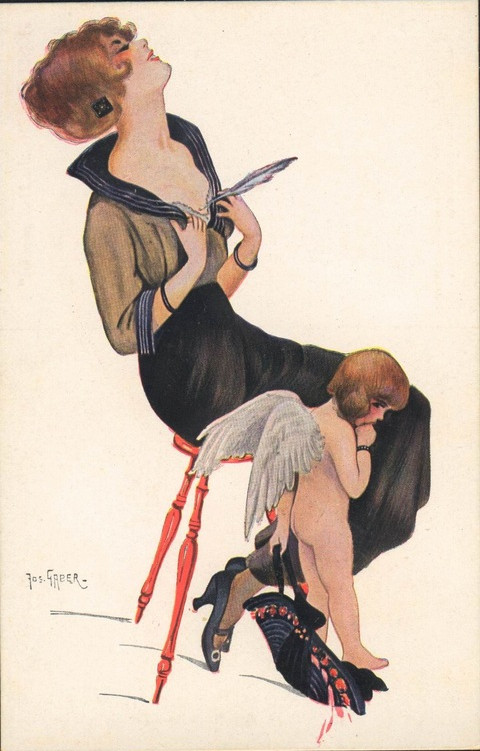
Gaber - GKVB-451
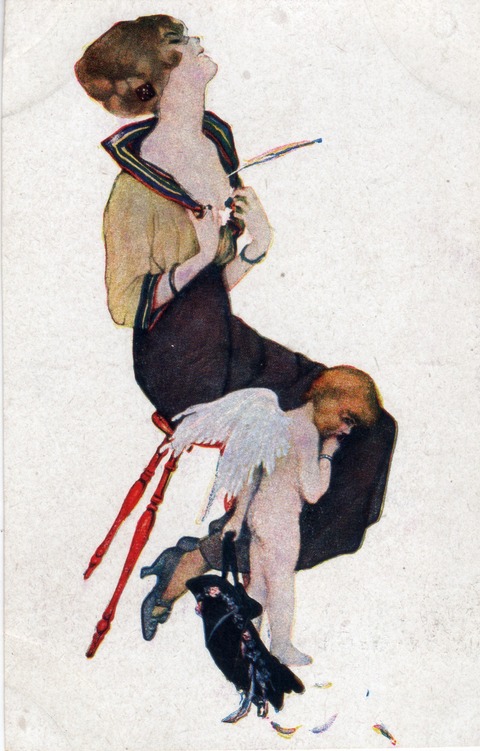
Kirchner - N.2-7
Il nostro stupore aumenta ancora di più osservando un’altra cartolina di Gaber con titolo tedesco “Ins Herz getroffen” oppure con doppio titolo francese e tedesco “Touchè au coeur” “Ins Herz getroffen” pubblicata da GKVB-451 (Graphische Kunst und Verlagsanstalt Berlin-Schöneberg).
È la stessa immagine della cartolina di Kirchner (N.2-7) che ebbe molta popolarità e diffusione. Il disegno di Kirchner, apparso come copertina o tavola a piena pagina sulle riviste francesi e inglesi La Vie Parisienne (n.23 del 1914) e The Sketch (del dicembre 1915), fu in seguito ripreso nel 1917 sugli americani Puck, American Weekly, Cartoons Magazine e persino sul dorso delle carte da gioco della ditta Waddington’s, con titolo Cupid Triumph.
Last updated on January, 8th, 2023